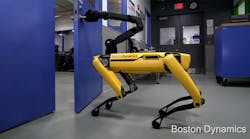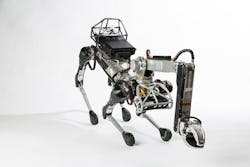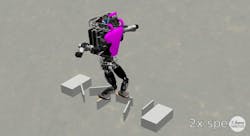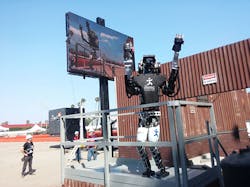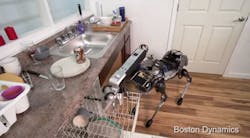Nearly five years ago, Boston Dynamics revealed its humanoid Atlas robot for the DARPA Robotics Challenge, a practical RFP for the U.S. government to find the best robotic first responder for a major disasters, like a nuclear plant meltdown. Opening a door was one of the required tasks for the 2015 competition, and the results were comically underwhelming.
As you can see, the 66-lb. robo-dog has less problems turning the handle and opening the door with its articulating 5-DoF arm and clamping gripper (the de facto neck and mouth) than many of us while holding a load of groceries.
It’s a testament to the Boston Dynamics crew’s ability to constantly impress. Last year, they got Atlas to back flip. While impressive and nearly impossible for most humans, toy dogs have been doing that for years. Humans take for granted our innate equilibrium; it takes a confluence of sensors, servos, motors, and highly complex algorithms for a robot to pull off the same feat.
This is certainly something we should all get excited about.
The industrial robots and cobots we've seen are stuck in place, or attached to a cumbersome bulky cart. The more manufacturers we talk to, the more we hear they put premium on space and flexibility. At a slim 2 ft and 8 in., MiniSpot is certainly compact. And its dexterity and mobility open up infinite possibilities in material handling, assembly, healthcare, and security.
Boston Dynamics SpotMini weighs 66 lbs. (with arm), and the battery powers the ultra-quiet robot for 90 minutes.
Sensors include:
- stereo cameras
- depth cameras
- IMU
- Position/force sensors in limbs
Of course, many of our peers in the consumer tech sector are making the lazy comparison to the Velociraptors in Jurassic Park, as a not-so-subtle nod to our innate fears that these robots will someday turn against us. This initial reaction indicates we need to overhaul our priorities here.
First off, people live with real dogs, who bite the hand that feeds them 4.5 million annually, according to the CDC. Heck, last summer, my usually affable boxer, nervous in our new house, sent me to the local urgent care center for stitches. And for some inexplicable reason, pit bulls, which occasionally rip babies’ faces off, are one of the nation’s most beloved breeds. This isn’t to say all dogs, or even all pit bulls, are dangerous, but to demonstrate our collective cognitive dissonance involving robots.
It is infinitely easier to control the software in a machine than undo millions of years of evolution or even a few months of abuse and neglect. Yet, the major message being pushed is “Uh oh, look what science did now!” with follow-up whispers of “Isn’t it cool, though?”
This type of negative association we all have (myself included) whenever a robot takes a new step forward is obviously detrimental to adoption. It’s a problem Atlas already faced. Using a walking algorithm developed by the Institute for Human & Machine Cognition (IHMC), Atlas could hike snow-covered hills and traverse narrow beams.
This was in 2016, when Google owned Boston Dynamics.
Bloomberg published an internal email attributed Google X spokesperson Courtney Hohne that expressed dismay about the breakthrough in mechanical mobility:
"There's excitement from the tech press, but we're also starting to see some negative threads about it being terrifying, ready to take humans' jobs."
This is a recurring there in human civilization, punctuated by Luddites, English textile workers who destroyed their perceived enemy, the automated loom. Their real enemies were rampant pollution and greed, but you can’t necessarily bash those to bits. And they are welcome to try and attack SpotMini, or his bigger brethren, Big Dog and Spot, but even when you kick them, they keep coming back:
Technological progress ain’t stopping, but it can be slowed. Dragging feet and coddling the ignorant can save few low-wage jobs for a year or two, while Japan and China integrate robots seamlessly into their workforce. Industrial irrelevance: now that’s something real to fear.
The more neo-Luddites out there that relate SpotMini to the fictional man-made killing machines in Jurassic Park, the harder it is to talk about the real value these robots could provide:
Emergency Response:
Does this answer DARPA’s question on what the most viable form factor a rescue robot should take? It seems for balance and leverage, four legs are better than two. Imagine if every fire department had one of these to deploy in severe conflagrations. How many lives would be saved?
Manufacturing/ Industry:
Instead of worrying about what would happen in the event of the technological singularity and a supreme AI takes control of all the world’s robo-dogs, what if we focused on industrial uses—the ways these robots could work for us? Manufacturers have already deployed mobile carts with six-axis arms for certain assembly operations. You can release these hounds in exponentially more environments, from outdoors to multiple levels.
Likes; Flat surfaces.
Dislikes: Stairs, narrow pathways.
Home Use:
It’s completely understand and natural to be skeptical of new tech, especially when it fills the Jungian archetype of the predators our ape-like ancestors likely faced. It’s foreign and frightening and tyeeters on the precipice of the Uncanny Valley. My editor says MiniSpot’s movements reminded him of the Demodogs from Stranger Things.
We can all agree that the appearance would need be softened a bit for people to want one in their home. And when they arrive, they could transform home care for the elderly, fetching items from downstairs. What if it could deliver a warm bottle to a crying baby in the middle of the night? They can already do the dishes.
And SoftBank has previously made the adorable Pepper and Nao, so if a consumer model does ever get released, it’s more likely to look like Lassie than Cujo.
A major barrier to widespread home adoption is that you can relate to a real dogs and earn their trust and loyalty; while a hacker could theoretically hijack SpotMini and have it do some pretty sordid things to you. All this means is your four-legged security system itself will need a solid cybersecurity system itself.
These examples are merely the low-hanging fruit, as obvious as comparing robo-dogs to cloned dinos. Advancing the tech Boston Dynamics routinely demonstrates has the potential to create new jobs making and programming these platforms, which in turn will improve the quality of life for us all.
It’s the reason SoftBank bought them, as CEO Masayoshi Son stated:
Smart robotics are going to be a key driver of the next stage of the Information Revolution, and Marc [Raibert]and his team at Boston Dynamics are the clear technology leaders in advanced dynamic robots. I am thrilled to welcome them to the SoftBank family and look forward to supporting them as they continue to advance the field of robotics and explore applications that can help make life easier, safer and more fulfilling.
So next video we see, let’s try our best to remain calm and think about all the positives before going right to sci-fi horror territory. We are living in a pivotal moment in human history, and our perception of our reality will play a huge role in how it goes.
(Of course, all this goes out the window if they release a giant robot centipede. I’d go back to pioneer days before standing for those monsters crawling about.)










